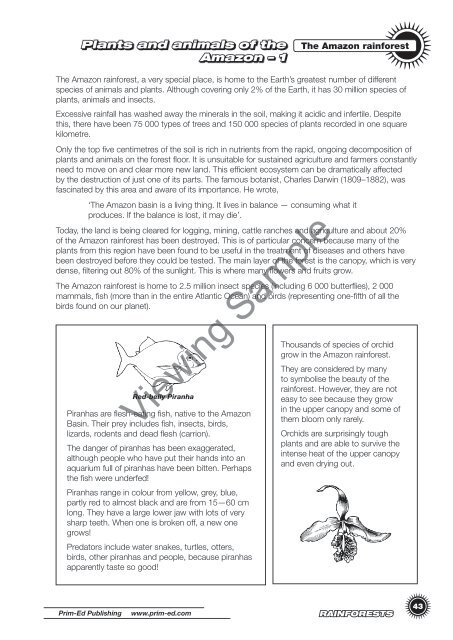PR-6422UK Literacy and Geography Themes - Rainforests
Create successful ePaper yourself
Turn your PDF publications into a flip-book with our unique Google optimized e-Paper software.
Plants <strong>and</strong> animals of the<br />
Amazon – 1<br />
The Amazon rainforest<br />
The Amazon rainforest, a very special place, is home to the Earth’s greatest number of different<br />
species of animals <strong>and</strong> plants. Although covering only 2% of the Earth, it has 30 million species of<br />
plants, animals <strong>and</strong> insects.<br />
Excessive rainfall has washed away the minerals in the soil, making it acidic <strong>and</strong> infertile. Despite<br />
this, there have been 75 000 types of trees <strong>and</strong> 150 000 species of plants recorded in one square<br />
kilometre.<br />
Only the top five centimetres of the soil is rich in nutrients from the rapid, ongoing decomposition of<br />
plants <strong>and</strong> animals on the forest floor. It is unsuitable for sustained agriculture <strong>and</strong> farmers constantly<br />
need to move on <strong>and</strong> clear more new l<strong>and</strong>. This efficient ecosystem can be dramatically affected<br />
by the destruction of just one of its parts. The famous botanist, Charles Darwin (1809–1882), was<br />
fascinated by this area <strong>and</strong> aware of its importance. He wrote,<br />
‘The Amazon basin is a living thing. It lives in balance — consuming what it<br />
produces. If the balance is lost, it may die’.<br />
Today, the l<strong>and</strong> is being cleared for logging, mining, cattle ranches <strong>and</strong> agriculture <strong>and</strong> about 20%<br />
of the Amazon rainforest has been destroyed. This is of particular concern because many of the<br />
plants from this region have been found to be useful in the treatment of diseases <strong>and</strong> others have<br />
been destroyed before they could be tested. The main layer of the forest is the canopy, which is very<br />
dense, filtering out 80% of the sunlight. This is where many flowers <strong>and</strong> fruits grow.<br />
The Amazon rainforest is home to 2.5 million insect species (including 6 000 butterflies), 2 000<br />
mammals, fish (more than in the entire Atlantic Ocean) <strong>and</strong> birds (representing one-fifth of all the<br />
birds found on our planet).<br />
Red-belly Piranha<br />
Viewing Sample<br />
Piranhas are flesh-eating fish, native to the Amazon<br />
Basin. Their prey includes fish, insects, birds,<br />
lizards, rodents <strong>and</strong> dead flesh (carrion).<br />
The danger of piranhas has been exaggerated,<br />
although people who have put their h<strong>and</strong>s into an<br />
aquarium full of piranhas have been bitten. Perhaps<br />
the fish were underfed!<br />
Piranhas range in colour from yellow, grey, blue,<br />
partly red to almost black <strong>and</strong> are from 15—60 cm<br />
long. They have a large lower jaw with lots of very<br />
sharp teeth. When one is broken off, a new one<br />
grows!<br />
Predators include water snakes, turtles, otters,<br />
birds, other piranhas <strong>and</strong> people, because piranhas<br />
apparently taste so good!<br />
Thous<strong>and</strong>s of species of orchid<br />
grow in the Amazon rainforest.<br />
They are considered by many<br />
to symbolise the beauty of the<br />
rainforest. However, they are not<br />
easy to see because they grow<br />
in the upper canopy <strong>and</strong> some of<br />
them bloom only rarely.<br />
Orchids are surprisingly tough<br />
plants <strong>and</strong> are able to survive the<br />
intense heat of the upper canopy<br />
<strong>and</strong> even drying out.<br />
Prim-Ed Publishing<br />
www.prim-ed.com<br />
RAINFORESTS<br />
43


















